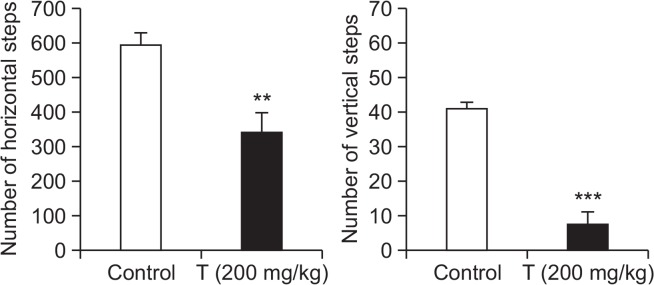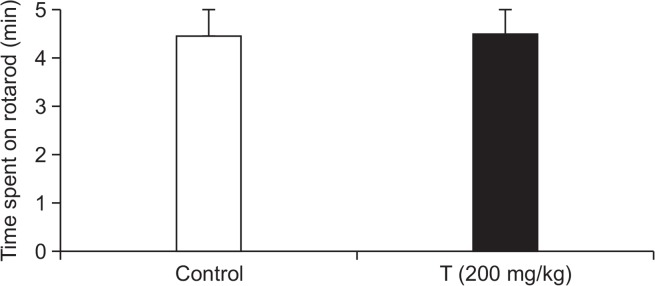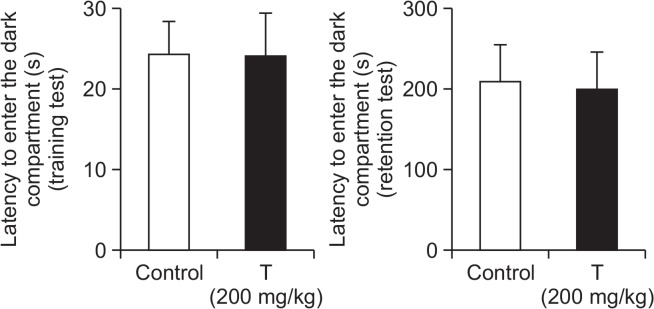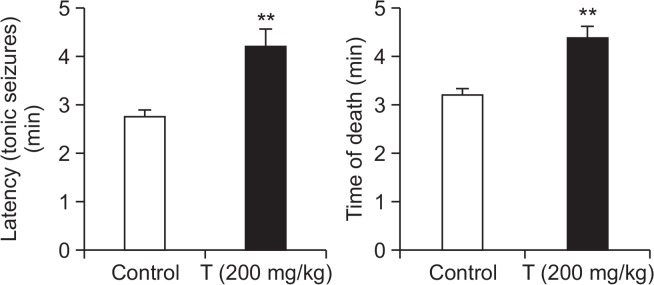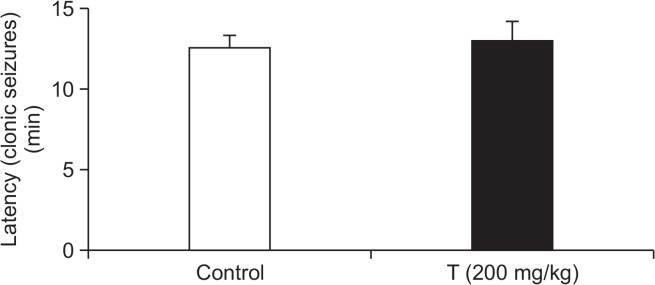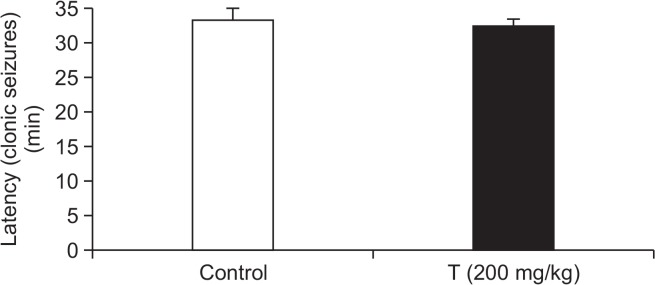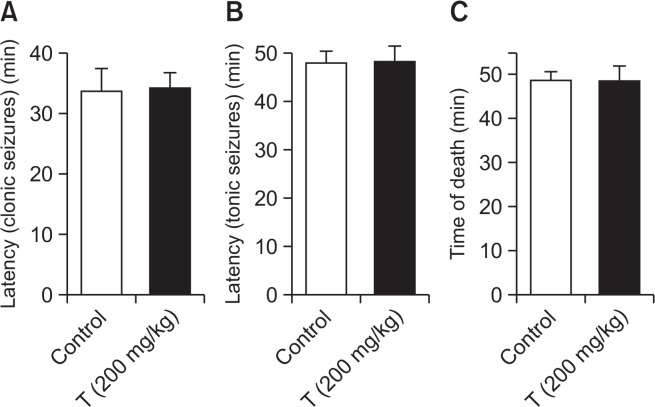Abstract
Taurine has a number of beneficial pharmacological actions in the brain such as anxiolytic and neuroprotective actions. We explored to test whether taurine could be transported to the central nervous system through the intranasal route. Following intranasal administration of taurine in mice, elevated plus maze test, activity cage test and rota rod test were carried out to verify taurine’s effect on anxiety. For the characterization of potential mechanism of taurine’s anti-anxiety action, mouse convulsion tests with strychnine, picrotoxin, yohimbine, and isoniazid were employed. A significant increase in the time spent in the open arms was observed when taurine was administered through the nasal route in the elevated plus maze test. In addition, vertical and horizontal activities of mice treated with taurine via intranasal route were considerably diminished. These results support the hypothesis that taurine can be transported to the brain through intranasal route, thereby inducing anti-anxiety activity. Taurine’s anti-anxiety action may be mediated by the strychnine-sensitive glycine receptor as evidenced by the inhibition of strychnine-induced convulsion.
Keywords: Anti-anxiety, Taurine, Elevated plus maze test, Activity cage test, Strychnine, Glycine receptor
INTRODUCTION
Taurine, 2-aminoethane sulfonic acid, is classified as a β-amino acid. It has unique structural features such as the presence of sulfonic group and its β-form configuration (Zhang and Kim, 2007).
Though taurine is present in the body, its supply from diet is necessary due to the relatively low activity of the enzyme cysteinsulfinic acid decarboxylase that is the major regulator of taurine biosynthesis. Taurine is biosynthesized from cysteine and methionine mostly in the liver and synthesized taurine is transported to other organs through the taurine transporter (Huxtable and Barbeau, 1976; Huxtable, 1986).
Strikingly, taurine is present in the brain in a large amount and it exerts many important neuronal functions such as anticonvulsant, regulation of neuronal excitability, learning and memory formation, anti-aggressiveness, enhancing CNS development and anti-alcoholic effect (Huxtable, 1992).
There is an interesting proposal that taurine and its derivative glutaurine could work as a neurotransmitter or neuromodulator. Furthermore, taurine plays important roles in regulating the structural stability of cell membrane as well as depolarization-associated calcium channel activity (Kuriyama, 1980; Lin et al., 1983; Moran et al., 1988; Sturman, 1993).
The physiological importance of taurine was further supported by the study with taurine deficiency: generation of epilepsy is associated with taurine deficiency (Birdsall, 1998).
Taurine has been found to have potential anxiolytic effects in animal models (Chen et al., 2004; Kong et al., 2006) and zebrafish models (Rosemberg et al., 2012; Fontana et al., 2016, 2019; Mezzomoa et al., 2016); however, its exact mechanism of action remains to be fully characterized.
Benzodiazepines have long been used for the treatment of anxiety; however, various unwanted side effects have been reported such as memory impairment, addiction problem, and muscle relaxation. Thus, it will be necessary to develop new drugs with fewer side effects for the safety of patients. Considering that taurine is an agonist of strychnine-sensitive glycine receptors present in the rat striatum (Sergeeva and Haas, 2001), there is a good possibility that taurine could interact with the glycine receptor in vivo. However, the use of taurine for the brain is extremely difficult due to its poor penetration rate into the brain: taurine has a strong hydrophilicity and has sulfonic acid instead of carboxylic acid which makes it very hard to penetrate the blood brain barrier (Chung et al., 2012). Recently, intranasal administration methods have been used as an alternative route for the efficient delivery of bioactive molecules into the brain. Numerous studies have been reported dealing with the delivery of neuropeptides and proteins to the brain via nasal route (Kamei and Takeda-Morishita, 2015). Intranasal delivery of peptides has been employed for the treatment of neurodegenerative diseases (Meredith et al., 2015). It could allow for taurine to bypass the blood brain barrier, and thereby taurine could enter CNS via other routes such as trigeminal nerve and intercellular cleft in the olfactory epithelium (Kozlovskaya et al., 2014; Lochhead and Thorne, 2015).
In the present study, the possibility of nasal delivery of taurine to the CNS has been tested. We have presented evidence that taurine could be delivered to the brain, causing anti-anxiety action.
MATERIALS AND METHODS
Animals
Male ICR mice were purchased from Hanlim Experimental Animals Co (Hwaseong, Korea). Male ICR (25–30 g, 6 weeks old) mice were caged in a temperature (22 ± 2°C) and ventilation-controlled room with a 12-h light/dark cycle. A standard pellet diet and tap water were supplied ad libitum. Throughout the experiments, animals were processed according to the Animal Care and Use Guidelines issued by Kyung Hee University (Seoul, Korea). All experiment protocols were approved by the Institutional Animal Care and Use Committee of Kyung Hee University [KHUASP(SE)-15-114]. After one week of acclimation period, animals were used for the experiment. Strychnine, picrotoxin, yohimbine and isoniazid were purchased from Tocris (Minneapolis, MN, USA).
Intranasal taurine delivery to mice
Intranasal (IN) delivery of taurine was carried out as essentially described by Marks et al (2009). Briefly, mice were hand-restrained, placed in a supine position, and given five 10 microliter drops of 80 μg/μl taurine or saline (0.9%), into both nares to give 200 mg of taurine per kg body weight through a micropipette (Pipetman P-20, Gilson, Inc., Middleton, WI, USA). Mice were given an extra ten microliter treatment drop if the subject forcibly ejected or sneezed out solution. Mice were held supine for 5–10 s after delivery to make sure all taurine containing solution was inhaled.
Elevated plus maze test
The plus maze, consisting of two open arms (60×5 cm) and two enclosed arms (60×5×20 cm) and elevated to a height of 60 cm, was used as described earlier by Pellow et al (1985). Mice were treated with saline or taurine (200 mg/kg, IN) and 60 min later were placed individually in the center of the plus maze, facing the enclosed arm. The time spent in the enclosed and open arms and the number of entries to the enclosed and open arms during the 5-min test period were recorded.
Activity Cage test
Groups of 10 mice with a weight between 35 and 40 g were used. They were treated intranasally with saline or taurine (200 mg/kg, IN). 1 h later, the mice were tested for spontaneous locomotor activity associated with anxiety for 4 min by the use of Activity Cage purchased from Ugo Basile (Gemonio, Italy) (Amos et al., 2004; Votava et al., 2005). Briefly, following the treatment of taurine or saline, the mice were evaluated for horizontal and vertical activities for 4 min according to the provider’s instruction manual.
Rota rod test
Each mouse was trained to run in a Rota rod (3 cm in diameter, 15 rpm) until it could remain there for 300 s without falling. The mice were then evaluated in a Rota rod performance test for 300 s, 60 min after distilled water or taurine (200 mg/kg, IN) treatment (Tsuda et al., 1996).
Passive avoidance test
The test was basically performed according to the step-through method described earlier (Park et al., 2000). The Gemini Avoidance System (SD Instruments, San Diego, CA, USA) was used for this experiment. The apparatus consisted of a two-compartment acrylic box with a lightened compartment connected to a darkened one by an automatic guillotine door. Mice were placed in the lighted box for 300 s, then the guillotine door was opened. The mice, as soon as they entered the dark compartment, received a punishing electrical shock (0.3 mA, 1 s). The latency times for entering the dark compartment were measured in the training test and after 24 h in the retention test. The maximum entry latency allowed in the retention session was 180s (Mohamed et al., 2000). Taurine (200 mg/kg, IN) or distilled water were administered 60 min prior to the training session of passive avoidance test.
Strychnine-Induced convulsions
Groups of 10 mice with a weight between 35 and 40 g were used. They were treated intranasal with distilled water or taurine (200 mg/kg, IN). 1 h later the mice were injected with 2 mg/kg strychnine i.p. The time until occurrence of tonic extensor convulsion and death was noted during a 1-h period (Bigler, 1977).
Picrotoxin-Induced convulsions
Groups of 10 mice with a weight between 35 and 40 g were used. They were treated intranasal with distilled water or taurine (200 mg/kg, IN). 1 h later the mice were injected with 3.5 mg/kg picrotoxin s.c. The time until occurrence of clonic seizure was noted during a 30-min period (Usunoff et al., 1969).
Yohimbine-Induced convulsions
Groups of 10 mice with a weight between 35 and 40 g were used. They were treated intranasal with distilled water or taurine (200 mg/kg, IN). 1 h later the mice were injected with 45 mg/kg yohimbine s.c. The time until occurrence of clonic seizure during a 60-min period was recorded (Dunn and Fielding, 1987).
Isoniazid-Induced convulsions
Groups of 10 mice with a weight between 35 and 40 g were used. They were treated intranasal with distilled water or taurine (200 mg/kg, IN). 1 h later the mice were injected with 45 mg/kg isoniazid s.c. The time until occurrence of clonic and tonic seizures and the time to death were recorded during a 2-h period (Meredith et al., 2015).
Statistical analysis
Each value is expressed as the mean and standard error of the mean (SEM) of multiple determinations. All statistical analyses were used Prism 5.0 software (GraphPad Software, San Diego, CA, USA). Analysis of a non-parametric unpaired t-test were used. The differences were considered statistically significant at p<0.05.
RESULTS
Elevated plus maze test
Elevated plus maze test was employed to explore the potential anti-anxiety actions of intra nasally (IN) administered taurine. There was no significant difference in terms of total arms entries (Fig. 1A) and total time spent in the arms (Fig. 1B) between control and taurine groups.
Fig. 1.
Effect of taurine on anxiety in the elevated plus maze test in mice. Following taurine administration (200 mg/kg, IN), the elevated plus maze test was performed as described in the Materials and Methods. Data are expressed as mean ± SEM. *p<0.05; **p<0.01; ***p<0.001, compared to the control group (n=8).
Administration of taurine (200 mg/kg, IN) caused a significant increase in the percent open arm entries (open arm/total×100): control and taurine (200 mg/kg) were 28.7% and 45.7%, respectively (Fig. 1C). Percent time spent in open arms was also significantly increased by taurine treatment (200 mg/kg, IN): control and taurine (200 mg/kg) were 12.6% and 33.6%, respectively (Fig. 1D). The actual time spent in open arms in control group and taurine treated group was 0.49 min and 1.16 min, respectively (Fig. 1E). The actual number of entries in open arms in control group and taurine treated group was 3.43 min and 2.27 min, respectively (Fig. 1F).
Activity cage test
Activity cage tests are another widely accepted as an experimental tool to test anti-anxiety actions of drugs. Following taurine administration (200 mg/kg, IN), mice were delivered to the activity cage for 4 min, and evaluated for horizontal and vertical activities. Taurine treatment caused a decrease in the horizontal steps by 43%, and it also diminished the vertical steps by 81% as compared to controls (Fig. 2).
Fig. 2.
Effect of taurine on spontaneous locomotor activity in the activity cage test in mice. Following taurine administration (200 mg/kg, IN) the activity cage test was performed as described in the Materials and Methods. Data are expressed as mean ± SEM. **p<0.01; ***p<0.001, compared to the control group (n=8).
Rota rod test
To explore the potential effect of taurine on the muscle relaxation, rota rod test were performed. Taurine administration (200 mg/kg, IN) did not cause any significant changes on the rota rod test, suggesting it had little effect on muscle relaxation (Fig. 3).
Fig. 3.
Effect of taurine on muscle relaxation in the Rota rod test in mice. Following taurine administration (200 mg/kg, IN), the Rota rod test was carried out as described in the Materials and Methods. The time spent on the Rota rod was measured. Data are expressed as mean ± SEM (n=8).
Passive avoidance test
To evaluate taurine’s potential effect on the memory formation, passive avoidance test was carried out. Taurine administration via intra nasal route (200 mg/kg, IN) did not change the retention times in the training and test session, suggesting it has little direct effect on the memory function (Fig. 4).
Fig. 4.
Effect of taurine on cognition in the passive avoidance test in mice. Following taurine administration (200 mg/kg, IN), passive avoidance test was performed as described in the Materials and Methods. Latency to enter the dark compartment was measured in the training test and the retention. Data are expressed as mean ± SEM (n=8).
Convulsions test
Taurine, at a dose 200 mg/kg, increased the latency to the onset of the first clonic seizure caused by strychnine by 40% as compared to control (Fig. 5). Taurine prolonged the induction time of death by 20% as compared to control, (Fig. 5). However, taurine had little effect on the latency to the onset of convulsion caused by picrotoxin (Fig. 6) and yohimbine (Fig. 7). Taurine had little effect on the latency to the clonic and tonic seizures as well as the time of death caused by isoniazid (Fig. 8).
Fig. 5.
Effect of taurine on the strychnine-induced convulsion in mice. Following taurine administration (200 mg/kg, IN), convulsion was induced by strychnine as described in the Materials and Methods. Latency to convulsion and the time of death was measured. Data are expressed as mean ± SEM. **p<0.01, compared to the control group (n=8).
Fig. 6.
Effect of taurine on the picrotoxin-induced convulsion in mice. Following taurine administration (200 mg/kg, IN), convulsion was induced by picrotoxin as described in the Materials and Methods. Latency to convulsion was measured. Data are expressed as mean ± SEM (n=8).
Fig. 7.
Effect of taurine on the yohimbine-induced convulsion in mice. Following taurine administration (200 mg/kg, /IN), convulsion was induced by yohimbine as described in the Materials and Methods. Latency to convulsion was measured. Data are expressed as mean ± SEM (n=8).
Fig. 8.
Effect of taurine on the isoniazid-induced convulsion in mice. Following taurine administration (200 mg/kg, IN), convulsion was induced by isoniazid as described in the Materials and Methods. Latency to (A) clonic and (B) tonic seizures and (C) the time of death was measured. Data are expressed as mean ± SEM (n=8).
DISCUSSION
Taurine, as a derivative of cysteine, exerts a wide variety of pharmacological actions in the body including CNS effects such as neuroprotection and anti-anxiety. Taurine have been extensively studied by many investigators in peripheral tissues; however, its actions in the CNS were not fully understood. As an alternative route of taurine administration, the possibility of nasal delivery of taurine to the brain was tested. We present evidence that taurine is readily transported into the brain via intranasal delivery, causing anxiolytic effects.
Taurine, 2-aminoethane sulfonic acid, is an important amino acid derivative playing essential physiological roles in the body such as bile acid conjugation, osmoregulation, cardiovascular regulation, antioxidation etc. Interestingly, taurine can be transported to the brain and can induce a number of CNS actions including anti-anxiety effect. However, its poor transport to the brain has limited its clinical application. We have previously found that taurine administration via PER ORAL could induce significant anti-anxiety effect through the activation of strychnine-sensitive glycine receptor (Zhang and Kim, 2007): this prompted us to further investigate the possibility of intranasal delivery of taurine for its anti-anxiety action. The anxiolytic action of taurine via intranasal delivery was evidenced by the activity cage test as well as the elevated plus maze test. It has been suggested that a decrease of horizontal and vertical activity by an agent is well correlated with its anxiolytic action (Amos et al., 2005).
Spontaneous locomotor activity measured by the activity cage test is regarded as an index of the level of excitability of the CNS (Mansur et al., 1971). Drug that causes a decrease of spontaneous locomotor activity can be anxiolytic (Ozturk et al., 1996). In the activity cage test, taurine administration via intranasal route caused remarkable reduction of horizontal and vertical activities, suggesting taurine’s anti-anxiety action. The activation of strychnine-sensitive glycine receptor by taurine could cause hyperpolarization of neuronal membrane via the receptor-associated chloride channels, which might lead to the anxiolytic action.
Elevated plus maze test is a commonly accepted tool for the evaluation of anti-anxiety action (Pellow et al., 1985). It is well documented that anxiolytic molecules increase the time spent in open arm in the elevated plus maze test. Taurine’s anti-anxiety action via intranasal delivery was clearly evident in the elevated plus maze test: the time spent in the open arm was significantly increased. Taurine administration via intranasal delivery has little effect on the muscle relaxation as shown by the Rota rod test. This feature of taurine is beneficial as compared to the conventional anxiolytic drug such as benzodiazepine which has muscle relaxation activity.
To explore the mechanism of taurine’s anti-anxiety action caused by intranasal delivery, convulsions induced by strychnine, picrotoxin, yohimbine or isoniazid were tested. The doses of strychnine, picrotoxin, yohimbine and isoniazid employed in the convulsion tests are widely used for the study of anxiolytic effects of compounds (Costa et al., 1975a, 1975b; Dunn and Fielding, 1987).
GABAA receptor is a ligand-gated chloride channel which has multiple binding sites for picrotoxin, yohimbine as well as GABA (Leite and Cascio, 2001).
Anion-selective transmitter-gated ion channels of the cysloop super family contain GABAA receptors and strychnine-sensitive glycine receptors (Yevenes and Zeilhofer, 2011). The binding of GABA to GABAA receptor causes a conformational change of the receptor complex, resulting in the hyperpolarization of neuronal cells via opening the chloride channel. By contrast, binding of picrotoxin or yohimbine to the GABAA receptor complex blocks the opening of chloride channel, causing convulsion. Thus, the present results that intranasal administration of taurine had little effect on the picrotoxin- and yohimbine-induced convulsion clearly suggest that taurine’s anti-anxiety action is not mediated by GABAA receptor. Since there is a possibility that taurine may affect the synthesis of GABA, isoniazid was employed. Isoniazid is a drug for the treatment of tuberculosis, but it also has been known to inhibit GABA synthesis and thereby inducing convulsion (Costa, 1975b).
When taurine was administered via intranasal route with the pretreatment of isoniazid, the convulsions induced by isoniazid were not affected. These results indicate that taurine has little effect on GABA synthesis process. Glycine receptor is another ligand-gated chloride channel which has a different structure as compared to the GABAA receptor. Activation of glycine receptor by binding with glycine induces a conformational change on the receptor and subsequently opens the associated chloride channel, causing sedation (Graham et al., 1982).
Strychnine-sensitive glycine receptors are pentameric anion channel consisting of α1-α4 and β (Lynch, 2004) and have a specific binding site for strychnine. When strychnine binds to the glycine receptor, it is inactivated with the associated chloride channel being closed, and eventually leading to convulsion. The strychnine-sensitive glycine receptors are expressed in various brain regions such as hippocampus, brain stem, spinal cord, cerebellum and retina (Legendre et al., 2009; Yevenes and Zeilhofer, 2011). They are playing important role in regulating respiratory rhythm, muscle tone, pain/sensory transmission and convulsion (Harvey et al., 2004; Reinold et al., 2005; Eichler et al., 2008; Manzke et al., 2010). A recent report has suggested a potential role of the strychnine-sensitive glycine receptor (Komatsu et al., 2015) in the control of anxiety. In the present study, the intranasal taurine delivery increased the time to induce convulsion caused by strychnine, suggesting taurine may exert anti-anxiety action through the activation of strychnine-sensitive glycine receptors.
Recently, the intranasal delivery of peptide and protein draws much attention as it provides an alternative route of CNS drug delivery (Meredith et al., 2015). Intranasal peptides and proteins directly diffuse into the brain through the intercellular cleft in the olfactory epithelium as well as through the trigeminal nerve (Kozlovskaya et al., 2014; Lochhead and Thorne, 2015). Interestingly, it has been found that there is indirect pathway for molecules to be transported in the brain via lymphatic or vasculature system and subsequently through blood brain barrier. We propose that the intranasally administered taurine could be transported to the brain via direct pathway(s) containing olfactory epithelium and/or trigeminal nerve. However, we cannot rule out the possibility that intra-nasally administered taurine may enter the brain lymphatic or vasculature system and subsequently pass through the blood brain barrier, exerting its anti-anxiety action. Since strychnine-sensitive glycine receptors are expressed hippocampus, brain stem, spinal cord, cerebellum and retina (Legendre et al., 2009; Yevenes and Zeilhofer, 2011), taurine transported via the intranasal pathway may interact with the strychnine-sensitive glycine receptors in the aforementioned brain regions and thereby inducing its CNS actions including anxiolytic activity. It has been found that the strychnine-sensitive glycine receptors are also expressed in adult rat amygdala (McCool and Botting, 2000) and taurine can activate these receptors (McCool and Chappell, 2007); this finding suggests that the intranasally delivered taurine could interact with the strychnine-sensitive glycine receptor to regulate anxiety in amygdala which plays important role in the regulation of emotion. It is also possible that taurine-induced anxiolytic behavior is mediated by dopamine regulation, considering that taurine elevates dopamine levels in nucleus accumbens (Ericson et al., 2006).
Taken together, it has been clearly demonstrated that taurine could be delivered to the brain system via intranasal route, inducing anti-anxiety action. These results suggest that intranasal administration could be an alternative route for the delivery of taurine into the brain to induce anti-anxiety action. Intranasal delivery of taurine could be considered in clinical situations requiring anxiety control. In conclusion, taurine exerts a significant anti-anxiety action via intranasal delivery, possibly due to its binding to and activating strychnine-sensitive glycine receptor in vivo. Future studies are necessary to compare the efficacy of intranasal administration of taurine with other administration routes.
REFERENCES
- Amos S, Akah PA, Enwerem N, Chindo BA, Hussaini IM, Wambebe C, Gamaniel KK. Behavioural effect of Pavetta cassipes extract on rodents. Pharmacol Biochem Behav. 2004;77:751–759. doi: 10.1016/j.pbb.2004.01.020. [DOI] [PubMed] [Google Scholar]
- Amos S, Abbah J, Chindo B, Edmond I, Binda L, Adzu B, Buhari S, Odutola AA, Wambebe C, Gamaniel K. Neuropharmacological effects of the aqueous extract of Nauclea latifolia root bark in rats and mice. J Ethnopharmacol. 2005;97:53–57. doi: 10.1016/j.jep.2004.10.003. [DOI] [PubMed] [Google Scholar]
- Bigler ED. Comparison of effects of bicuculline, strychnine, and picrotoxin with those of pentylenetetrazol on photically evoked afterdischarges. Epilepsia. 1977;18:465–470. doi: 10.1111/j.1528-1157.1977.tb04993.x. [DOI] [PubMed] [Google Scholar]
- Birdsall TC. Therapeutic application of taurine. Altern Med Rev. 1998;3:128–136. [PubMed] [Google Scholar]
- Chen SW, Kong WX, Zhang YJ, Li YL, Mi XJ, Mu XS. Possible anxiolytic effects of taurine in the mouse elevated plus maze. Life Sci. 2004;75:1503–1511. doi: 10.1016/j.lfs.2004.03.010. [DOI] [PubMed] [Google Scholar]
- Chung MC, Malatesta P, Bosquesi PL, Yamasaki PR, dos Santos JL, Vizioli EO. advances in drug design based on the amino acid approach: taurine analogues for the treatment of CNS diseases. Pharmaceuticals. 2012;5:1128–1146. doi: 10.3390/ph5101128. [DOI] [PMC free article] [PubMed] [Google Scholar]
- Costa E, Guidotti A, Mao CC. New concepts in the mechanism of action of benzodiazepines. Life Sci. 1975a;17:167–186. doi: 10.1016/0024-3205(75)90501-9. [DOI] [PubMed] [Google Scholar]
- Costa E, Guidotti A, Mao CC. Evidence for involvement of GABA in the action of benzodiazepines: studies on rat cerebellum. Adv. Biochem. Psychopharmacol. 1975b;(14):113–130. [PubMed] [Google Scholar]
- Dunn R, Fielding S. Yohimbine-induced seizures in mice. A model predictive of potential anxiolytic and GABA-mimetic agents. Drug Dev Res. 1987;10:177–188. doi: 10.1002/ddr.430100306. [DOI] [Google Scholar]
- Eichler SA, Kirischuk S, Juttner R, Schafermeier PK, Legendre P, Lehman TN, Gloveli T, Grantyn R, Meier JC. Glycinergic tonic inhibition of hippocampal neurons with depolarizing GABAergic transmission elicits histopathological signs of temporal lobe epilepsy. J Cell Mol Med. 2008;12:2848–2866. doi: 10.1111/j.1582-4934.2008.00357.x. [DOI] [PMC free article] [PubMed] [Google Scholar]
- Ericson M, Molander A, Stomberg R, Söderpalm B. Taurine elevates dopamine levels in the rat nucleus accumbens; antagonism by strychnine. Eur J Neurosci. 2006;23:3225–3229. doi: 10.1111/j.1460-9568.2006.04868.x. [DOI] [PubMed] [Google Scholar]
- Fontana BD, Meinerz DL, Rosa LVC, Mezzomo NJ, Silveira A. Modulatory action of taurine on ethanol-induced aggressive behavior in zebrafish. Pharmacol Biochem Behav. 2016;141:18–27. doi: 10.1016/j.pbb.2015.11.011. [DOI] [PubMed] [Google Scholar]
- Fontana BD, Ziani PR, Canzian J, Mezzomo NJ, Müller TE, dos Santos MM, Loro VL, Barbosa NV, Mello CF, Rosemberg DB. Taurine protects from pentylenetetrazole-induced behavioral and neurochemical changes in zebrafish. Mol Neurobiol. 2019;56:583–594. doi: 10.1007/s12035-018-1107-8. [DOI] [PubMed] [Google Scholar]
- Graham D, Pfeiffer F, Betz H. Avermectin B1a inhibits the binding of strychnine to the glycine receptor of rat spinal cord. Neurosci Lett. 1982;29:173–176. doi: 10.1016/0304-3940(82)90349-4. [DOI] [PubMed] [Google Scholar]
- Harvey RJ, Depner UB, Wassle H, Ahmadi S, Heindl C, Reinold H, Smart TG, Harvey K, Schütz B, Abo-Salem OM, Zimmer A, Poisbeau P, Welzl H, Wolfer DP, Betz H, Zeilhofer HU, Müller U. GlyR α3: an essential target for spinal PGE2-mediated inflammatory pain sensitization. Science. 2004;304:884–887. doi: 10.1126/science.1094925. [DOI] [PubMed] [Google Scholar]
- Huxtable RJ. The Biochemistry of Sulfur. Plenum Press; New York: 1986. [DOI] [Google Scholar]
- Huxtable RJ, Barbeau A. Taurine. Raven Press; New York: 1976. [Google Scholar]
- Huxtable R. Physiological actions of taurine. Physiol Rev. 1992;72:101–163. doi: 10.1152/physrev.1992.72.1.101. [DOI] [PubMed] [Google Scholar]
- Kamei N, Takeda-Morishita M. Brain delivery of insulin boosted by intranasal coadministration with cell-penetrating peptides. J Control Release. 2015;197:105–110. doi: 10.1016/j.jconrel.2014.11.004. [DOI] [PubMed] [Google Scholar]
- Komatsu H, Furuya Y, Sawada K, Asada T. Involvement of the strychnine-sensitive glycine receptor in the anxiolytic effects of GlyT1 inhibitors on maternal separation-induced ultrasonic vocalization in rat pups. Eur J Pharmacol. 2015;746:252–257. doi: 10.1016/j.ejphar.2014.11.024. [DOI] [PubMed] [Google Scholar]
- Kong WX, Chen SW, Li YL, Zhang YJ, Wang R, Min L, Mi X. Effects of taurine on rat behaviors in three anxiety models. Pharmacol Biochem Behav. 2006;83:271–276. doi: 10.1016/j.pbb.2006.02.007. [DOI] [PubMed] [Google Scholar]
- Kozlovskaya L, Abou-Kaoud M, Stepensky D. Quantitative analysis of drug delivery to the brain via nasal route. J. Control Release. 2014;189:133–140. doi: 10.1016/j.jconrel.2014.06.053. [DOI] [PubMed] [Google Scholar]
- Kuriyama K. Taurine as a neuromodulator. Fed Proc. 1980;39:2680–2684. [PubMed] [Google Scholar]
- Legendre P, Forstera B, Juttner R, Meier JC. Glycine receptors caught between genome and proteome - functional implications of RNA editing and splicing. Front Mol Neurosci. 2009;2:23. doi: 10.3389/neuro.02.023.2009. [DOI] [PMC free article] [PubMed] [Google Scholar]
- Leite J, Cascio M. Structure of ligand-gated ion channels: critical assessment of biochemical data supports novel topology. Mol Cell Neurosci. 2001;17:777–792. doi: 10.1006/mcne.2001.0984. [DOI] [PubMed] [Google Scholar]
- Lin CT, Su YYT, Song GX, Wu JY. Is taurine a neurotransmitter in rabbit retina. Brain Res. 1983;337:293–298. doi: 10.1016/0006-8993(85)90066-6. [DOI] [PubMed] [Google Scholar]
- Lochhead JJ, Thorne RG. Intranasal delivery of biologics to the central nervous system. Adv Drug Deliv Rev. 2015;64:614–628. doi: 10.1016/j.addr.2011.11.002. [DOI] [PubMed] [Google Scholar]
- Lynch JW. Molecular structure and function of the glycine receptor chloride channel. Physiol Rev. 2004;84:1051–1095. doi: 10.1152/physrev.00042.2003. [DOI] [PubMed] [Google Scholar]
- Manzke T, Niebert M, Koch UR, Caley A, Vogelsesang S, Hulsmann S, Ponimaskin E, Müller U, Smart TG, Harvey RJ, Richter DW. Serotonin receptor 1A-modulated phosphorylation of glycine receptor α3 controls breathing in mice. J Clin Invest. 2010;120:4118–4128. doi: 10.1172/JCI43029. [DOI] [PMC free article] [PubMed] [Google Scholar]
- McCool BA, Botting SK. Characterization of strychnine-sensitive glycine receptors in acutely isolated adult rat basolateral amygdala neuron. Brain Res. 2000;859:341–351. doi: 10.1016/S0006-8993(00)02026-6. [DOI] [PubMed] [Google Scholar]
- McCool BA, Chappell A. Strychnine and taurine modulation of amygdala-associated anxiety-like behavior is ‘state’ dependent. Brain Res. 2007;178:70–81. doi: 10.1016/j.bbr.2006.12.002. [DOI] [PMC free article] [PubMed] [Google Scholar]
- Meredith ME, Salameh TS, Banks WA. intranasal delivery of proteins and peptides in the treatment of neurodegenerative diseases. AAPS J. 2015;17:780–787. doi: 10.1208/s12248-015-9719-7. [DOI] [PMC free article] [PubMed] [Google Scholar]
- Mezzomoa NJ, Silveira A, Giuliania GS, Quadrosa VA, Rosemberga DB. The role of taurine on anxiety-like behaviors in zebrafish: A comparative study using the novel tank and the light-dark tasks. Neurosci Lett. 2016;613:19–24. doi: 10.1016/j.neulet.2015.12.037. [DOI] [PubMed] [Google Scholar]
- Mohamed AF, Matsumoto K, Tabata K, Takayama H, Kitajima M, Aimi N, Watamabe H. Effects of Uncaria tomentosa total alkaloid and its components on experimental amnesia in mice elucidation using the passive avoidance test. J Pharm Pharmacol. 2000;52:1553–1561. doi: 10.1211/0022357001777612. [DOI] [PubMed] [Google Scholar]
- Moran J, Solazar P, Pasantes-Morales H. Effect of tocopherol and taurine on membrane fluidity of retinal rod outer segments. Exp Eye Res. 1988;45:769–776. doi: 10.1016/S0014-4835(87)80094-5. [DOI] [PubMed] [Google Scholar]
- Mansur J, Martz RMW, Carlini EA. Effects of acute and chronic administration of Cannabis sativa and (−) 9-trans tetrahedron cannabinol on the behaviour of rats in an open field arena. Psychopharmacology. 1971;19:338–397. doi: 10.1007/BF00404383. [DOI] [PubMed] [Google Scholar]
- Marks DR, Tucker K, Cavallin MA, Mast TG, Fadool DA. Awake intranasal insulin delivery modifies protein complexes and alters memory, anxiety, and olfactory behaviors. J Neurosci. 2009;29:6734–6751. doi: 10.1523/JNEUROSCI.1350-09.2009. [DOI] [PMC free article] [PubMed] [Google Scholar]
- Ozturk Y, Aydine S, Ben R, Baser KHC, Berberoglu H. Behavioural effects of Hypericum perforatum L and Hypericum calycinum L. extracts on the central nervous systems in mice. Phytomedicine. 1996;3:139–146. doi: 10.1016/S0944-7113(96)80027-4. [DOI] [PubMed] [Google Scholar]
- Park CR, Seeley RJ, Craft S, Wood SC. Intracere-broventricular insulin enhances memory in a passive-avoidance task. Physiol Behav. 2000;68:509–514. doi: 10.1016/S0031-9384(99)00220-6. [DOI] [PubMed] [Google Scholar]
- Pellow S, Chopin PH, File SE, Briley M. Validation of open:closed arm entries in an elevated plus-maze as a measure of anxiety in the rat. J. Neurosci Methods. 1985;14:149–167. doi: 10.1016/0165-0270(85)90031-7. [DOI] [PubMed] [Google Scholar]
- Reinold H, Ahmadi S, Depner UB, Layh B, Heindl C, Hamza M, Pahl A, Brune K, Narumiya S, Müller U, Zeilhofer HU. Spinal inflammatory hyperalgesia is mediated by prostaglandin E receptors of the EP2 subtype. J Clin Invest. 2005;115:673–679. doi: 10.1172/JCI23618. [DOI] [PMC free article] [PubMed] [Google Scholar]
- Rosemberg DB, Braga MM, Rico EP, Loss CM, Córdova SD, Mussulini BHM, Blaser RE, Leite CE, Campos MM, Dias RD, Calcagnotto ME, de Oliveira DL, Souza DO. Behavioral effects of taurine pretreatment in zebrafish acutely exposed to ethanol. Neuropharmacology. 2012;63:613–623. doi: 10.1016/j.neuropharm.2012.05.009. [DOI] [PubMed] [Google Scholar]
- Sergeeva OA, Haas HL. Expression and function of glycine receptor in striatal cholinergic interneurons from rat and mouse. Neuroscience. 2001;104:1043–1055. doi: 10.1016/S0306-4522(01)00130-0. [DOI] [PubMed] [Google Scholar]
- Sturman JA. Taurine in development. J Physiol Rev. 1993;73:119–147. doi: 10.1152/physrev.1993.73.1.119. [DOI] [PubMed] [Google Scholar]
- Tsuda M, Suzuki T, Misawa M, Nagase H. Involvement of the opioid in the anxiolytic effect of diazepam in mice. Eur J Pharmacol. 1996;307:7–14. doi: 10.1016/0014-2999(96)00219-1. [DOI] [PubMed] [Google Scholar]
- Usunoff G, Atsev E, Tchavdarov D. On the mechanism of picrotoxin epileptic seizure (macro- and microelectrode investigations). Electroencephalogr Clin Neurophysiol. 1969;27:444–447. [PubMed] [Google Scholar]
- Votava M, Hess L, Slíva J, Krsiak M, Agová V. Dexme-detomidine selectively suppresses dominant behavior in aggressive and sociable mice. Eur J Pharmacol. 2005;523:79–85. doi: 10.1016/j.ejphar.2005.08.022. [DOI] [PubMed] [Google Scholar]
- Yevenes GE, Zeilhofer HU. Allosteric modulation of glycine receptors. Br J Pharmacol. 2011;164:224–36. doi: 10.1111/j.1476-5381.2011.01471.x. [DOI] [PMC free article] [PubMed] [Google Scholar]
- Zhang CG, Kim SJ. Taurine induces anti-anxiety by activating strychnine-sensitive glycine receptor in vivo. Ann Nutr Metab. 2007;51:379–386. doi: 10.1159/000107687. [DOI] [PubMed] [Google Scholar]




